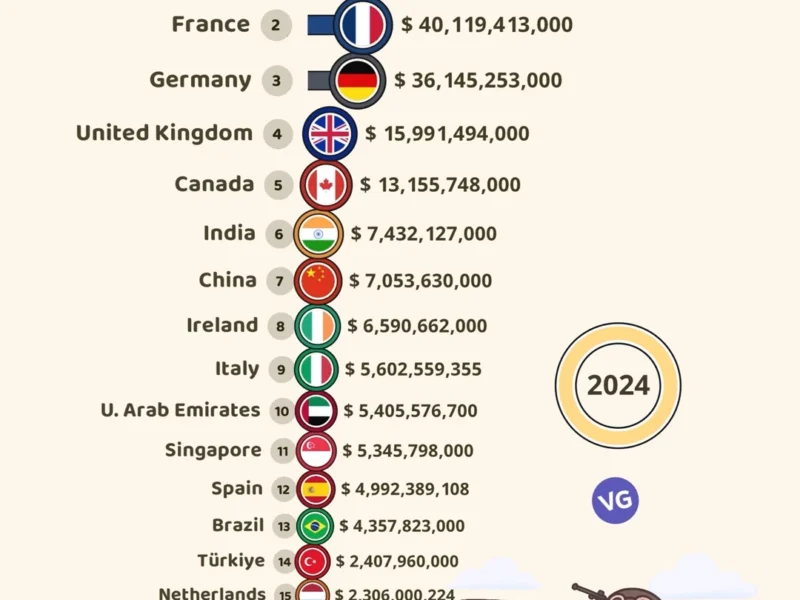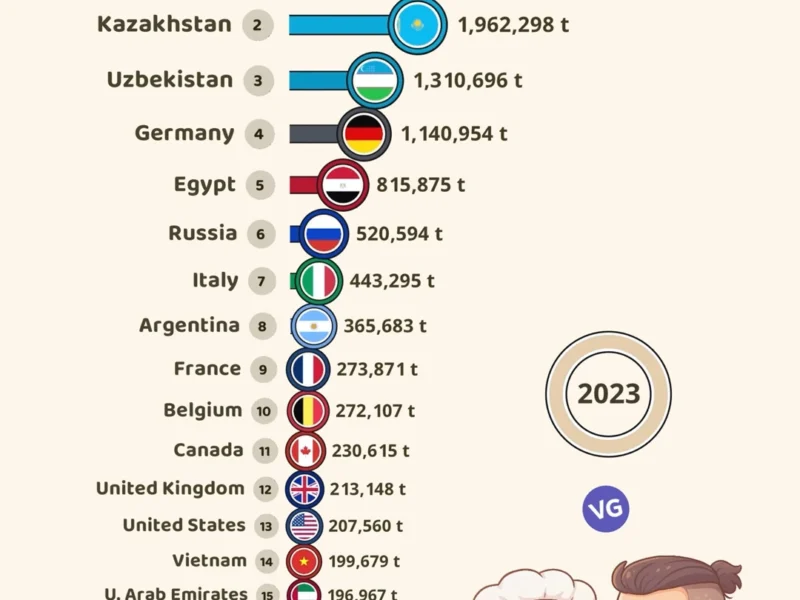Wheat is crucial for food security worldwide. It ranks third in global cereal production, following rice and maize. It’s second for human consumption. The trade of wheat surpasses all other crops. In 2020, over 760 million tons of wheat were grown globally.1 This vital crop comes from more than 80 countries. Yet, a few nations dominate the world’s wheat production.
Key Takeaways
- Wheat is the third most-produced cereal worldwide, after rice and maize.
- The global trade of wheat is greater than all other crops combined.
- Over 80 different countries produce wheat, but the majority of global wheat production comes from a few leading producers.
- Understanding the world’s largest wheat producers is crucial for ensuring global food security.
- Technological advancements and sustainable farming practices can help address challenges in wheat production.
China: The Undisputed Leader in Wheat Production
China is clearly ahead in the world when it comes to wheat. It produces more than anyone else. Over the last 20 years, it has made over 2.4 billion tonnes of wheat. This amount makes up about 17% of all wheat made globally during that time.2 China mainly uses this wheat to feed its own people. Chinese folks eat nearly one-fifth of the world’s wheat.
Staggering Output: Over 2.4 Billion Tonnes in 20 Years
China has produced a massive amount of wheat – more than 2.4 billion tonnes in 20 years.2 Its huge production makes it the world’s key player in wheat supply. This is vital for keeping up with the increasing worldwide demand for wheat.
Domestic Consumption: Meeting China’s Rising Food Demand
Most of the wheat from China goes to feed its own people. China uses the most wheat in the world. They eat about a quarter of the world’s wheat, almost half of its soybeans, and close to a fifth of its corn.2 The country plans to have each person consume 20% more meat by 2025. This food growth is why China focuses on growing a lot of wheat. It helps keep their huge population fed and secure.
India: The Second-Largest Wheat Grower
India comes second globally in producing wheat. It adds up to 12.5% of all the wheat made worldwide in the past 20 years.3 Much like China, India keeps most of its wheat at home. This helps make sure there is enough food for its people, aiming for food security.
Substantial Contributor: 12.5% of Global Wheat Production
In 2020, India made 107.9 million tons of wheat. This shows how big a role India plays in the world’s wheat supply, just after China4. Its share of 12.5% is crucial for feeding the world3.
Retaining Domestic Supply: Prioritizing National Food Security
India mainly focuses on providing wheat for its own people. It keeps a lot of its wheat inside the country. This is similar to China’s way, given its big population.3 By doing this, India makes sure its huge population has enough to eat.
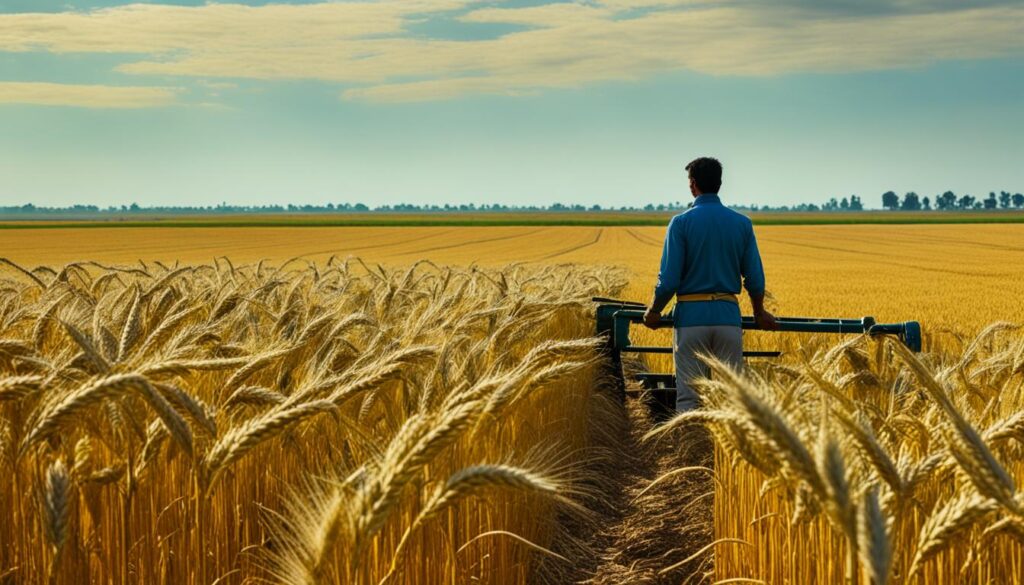
Russia: The Wheat Export Superpower
Russia is a top wheat producer and exporter. It exported over $7.3 billion of wheat in 2021.5 This made up about 13.1% of all global wheat sales. Russia shares this tag of being the world’s leading wheat supplier with Ukraine.5
Massive Export Volumes: $7.3 Billion in 2021
In 2021, Russia sold a record $7.3 billion of wheat worldwide.5 This big slice of the wheat trade was roughly 13.1%. It showed the world just how important Russia is in the wheat game.
Disruptions from the Russia-Ukraine Conflict
The Russia-Ukraine conflict in 2022 shook the wheat market.5 With these countries making up almost a third of the world’s wheat supply, the fighting hit global wheat flows. Prices shot up to historic levels.5
Egypt and Turkey are major buyers of Russia’s wheat.5 But, the conflict’s impact spread further. It even affected the United States, a top exporter of wheat. The crisis might disrupt U.S. wheat sales too.6
| Metric | Value |
|---|---|
| Russia’s Wheat Exports (2021) | $7.3 billion5 |
| Russia’s Share of Global Wheat Exports (2021) | 13.1%5 |
| Russia and Ukraine’s Combined Share of Global Wheat Trade | Nearly 30%5 |
| Estimated Decrease in Ukraine’s Wheat Output (2022-2023) | 41%6 |
United States: A Wheat Production Heavyweight
The United States is a big player in the wheat market, coming in fourth globally. It produced 49.8 million tonnes of wheat in 2020. This shows its strength as a leading wheat producer.7
Even though it does not lead worldwide, the US makes a big impact with its wheat. The USDA predicts a 3% increase in US wheat production for next year, reaching 51.7 million tons.7 This steady growth shows the country’s importance in supplying wheat to the world.
| Statistic | Value |
|---|---|
| US Wheat Production in 2020 | 49.8 million tonnes |
| Expected US Wheat Production Rise | 3% to 51.7 million tons |
| Illinois Average Wheat Yield in 2019 | 67 bushels per acre |
| US Average Wheat Yield in 2019 | 53 bushels per acre |
The US might not produce as much wheat as China and India, but its efficiency is impressive. In 2019, Illinois’ winter wheat yield averaged 67 bushels per acre, beating the US average of 53 bushels per acre.8 This shows the US’s potential for increased production through better methods and technology.
Canada: A Major Player in the Wheat Trade
Canada stands as the world’s fifth-largest maker of wheat. In 2020, it produced a whopping 35.4 million tonnes of wheat.9 This makes Canada a key player in the world’s wheat business, rated sixth. It follows top producers like China, the European Union, and the United States.9
Being world’s number two exporter, Canada ships out about 20 million tonnes of wheat yearly. This makes up 21% of the world’s wheat exports.9 Its main buyers are China and Japan, with noteworthy sales going to South Korea and the United States.9 Additionally, Canada leads in exporting durum wheat, making up 48% of total exports.
Aside from wheat, Canada is also big on other grains. From 1986 to 1995, they averaged at 23.2 million tonnes yearly, barley being the main one at 12.5 million tonnes.9 Canada comes in second in barley exports, right after the European Union. It has a share of 22% in the world market, exporting about 3.8 million tonnes yearly.9
Canada plays a key role in the canola market, covering 80% of global exports, shipping about four million tonnes a year. It’s highly sought-after by Japan, Mexico, and the United States.9 The space for growing canola in Western Canada has greatly increased over the past 15 years. It’s gone from two million to more than five million hectares, mainly in Saskatchewan and Alberta.9 Canadian canola exports make up just 10% of global oilseeds trade but a significant 80% of canola exports.
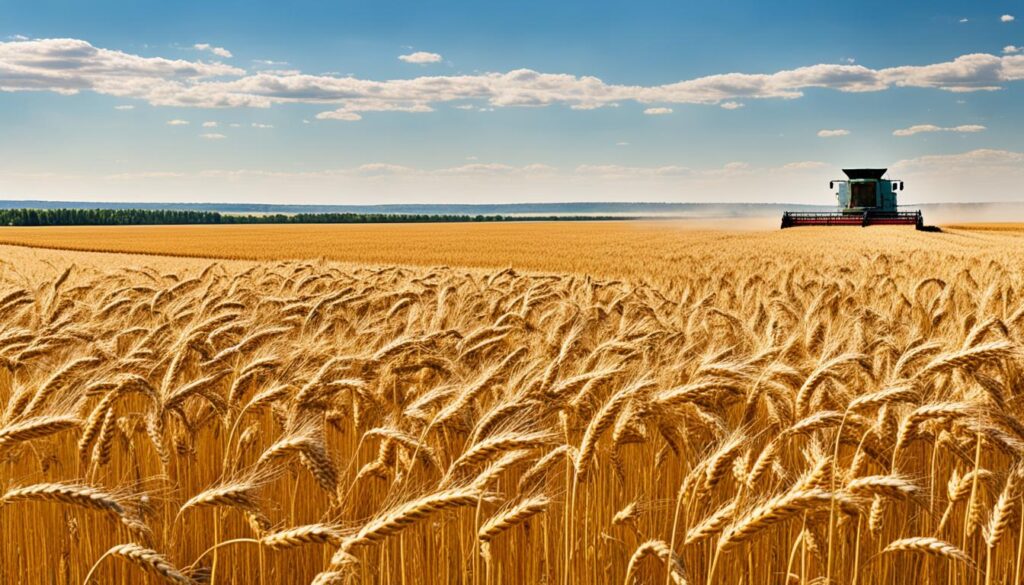
Largest Producer of Wheat in the World: Examining the Global Landscape
More than 80 countries grow wheat, but a handful lead in global production.10 China is the biggest producer, making 135,000,000 metric tonnes, which is 29% of the total.10 India comes second, with 103,000,000 metric tonnes produced.10
Top Wheat-Producing Countries: Global Rankings
10 Russia takes the third spot, producing 77,000 metric tonnes, and it’s the top exporter.10 The U.S. is fourth, with a production of 50,784,000 metric tonnes.10 France is fifth, producing almost 40,000,000 metric tonnes. Canada is next, at 34,000,000 metric tonnes, making big exports.10 Ukraine follows, producing 29,171,000 metric tonnes,10 while Pakistan does just below at 26,100,000 metric tonnes.10 Australia and Argentina complete the top ten, with Australia’s production jumping from 15,200,000 metric tonnes to 24,000,000 metric tonnes in a year and Argentina’s at 21,000,000 metric tonnes.10
Climatic Factors: Ideal Conditions for Wheat Cultivation
11 Wheat loves a temperate climate with 12 to 36 inches of rain a year.11 These perfect conditions, combined with farming know-how and technology, help the leading countries keep their top positions in the wheat market.
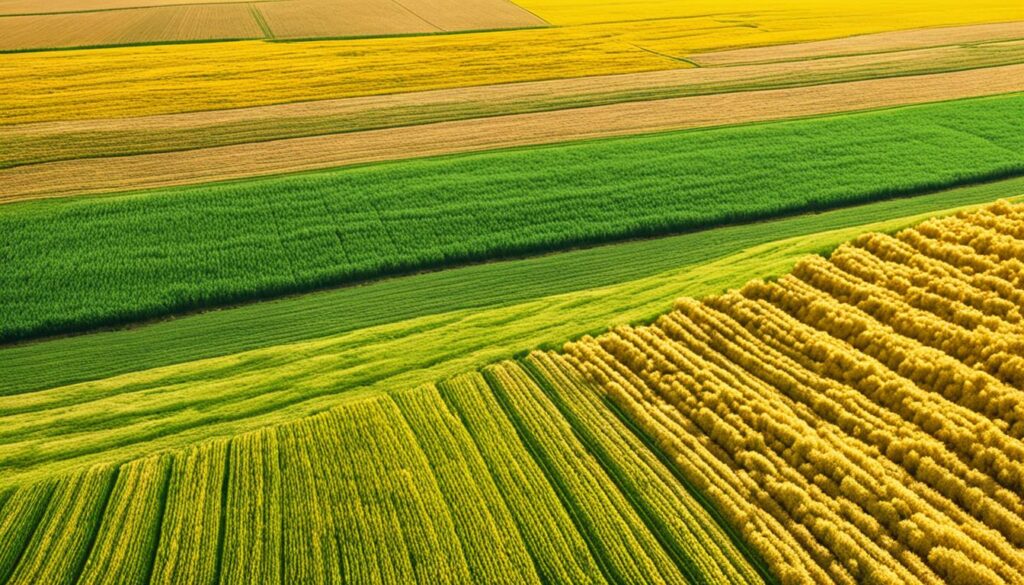
Wheat: A Dietary Staple for Millions
Wheat is a key food for many people across the globe.12 Besides being a staple, it offers crucial nutrients like plant-based protein, carbs, and fiber when you eat the whole grain.12
Nutritional Profile: Proteins, Carbohydrates, and Dietary Fiber
This cereal grain is packed with vital nutrients. It gives us plant protein, complex carbs, and fiber. These nutrients are vital for a well-rounded, healthy diet.12
Gluten Sensitivity: Celiac Disease and Non-Celiac Gluten Sensitivity
Not everyone can handle wheat’s protein, gluten. For some, it leads to problems such as celiac disease and non-celiac gluten sensitivity.12 Celiac disease causes the immune system to harm the small intestine if you eat gluten. On the other hand, non-celiac gluten sensitivity brings various digestive and other symptoms, but without the immune attack seen in celiac disease.
If you have these issues, staying away from wheat and other grains with gluten is critical. It helps in staying healthy and controlling symptoms.
Wheat faces big challenges from climate change and environmental problems. Things like droughts, extreme weather, and soil that’s getting worse can lower wheat harvests worldwide.13 For example, the United Nations says that in 2023, Ukraine might see 20-30% less wheat than in 2022 because of a conflict.13
Climate Change and Environmental Factors
Climate change brings higher temperatures, less predictable rain, and more extreme weather events. These factors hurt wheat production a lot.13 Droughts and heat waves are bad for wheat growth. Too much rain and floods can also ruin crops and make it hard to harvest.14 Poor soil quality and not enough nutrients also make growing wheat harder. The European Union expects wheat production to drop by 1.8 million tons compared to before.14
Technological Advancements in Wheat Farming
But, technology is helping farmers fight back. New farming tools and methods are making a difference. For instance, using GPS to plant crops in the right spots and drones to check on the fields can help a lot.13 There are also crop types that can resist diseases. And, better ways to water crops are improving how much wheat is grown.13
One cool invention is Locus AG biologicals. They can boost wheat production by 11% on average.13 Also, a product called Locus AG Pantego Duo for Wheat & Cereals has been proven to increase yields by 4.6 bushels per acre. This finding is backed by six different research centers, with great confidence.13
With the world’s population growing, we need to make sure there’s enough wheat for everyone. Thanks to tech progress, we’re getting better at fighting climate change and other farming problems. This way, the future of making wheat looks brighter.
| Wheat Production Metric | 2020-2021 | 2021-2022 | 2022-2023 (Forecast) | 2023-2024 (Forecast) |
|---|---|---|---|---|
| Global Wheat Production (million tons) | 760.0 | N/A | 783.313 | 798.014 |
| Global Wheat Utilization (million tons) | N/A | N/A | 783.013 | 803.014 |
| U.S. Wheat Farm Price ($/bushel) | 5.0513 | 7.6313 | 8.8513 | N/A |
| Wheat Yield Increase with Locus AG Pantego Duo (bu/acre) | N/A | N/A | 4.613 | N/A |
Conclusion: Securing the Future of Global Wheat Supply
Wheat is key to feeding many people and keeping global food secure.15 With the world’s population growing, a steady supply of wheat is vital. To make sure there’s enough wheat in the future, we need to look at the top wheat-making countries. We must understand how they grow wheat and what problems they face. Then, experts and farmers can build plans to secure the world’s wheat and keep up with the demand.
The conflict between Russia and Ukraine showed how much of the world depends on these countries for wheat. They export nearly a third of the world’s wheat. To be less reliant and more secure, areas like Eastern Europe could grow more wheat.15 Plus, we need to look for new places with great conditions for growing wheat. This approach is key to having enough wheat to trade with others by 2050.16
Dealing with climate change and a growing population will test how we secure wheat’s future. To do this, we have to change policies, make new rules, and invest in farming. These efforts aim to help countries grow enough wheat for their own people. New farming technology is also important.15 Everyone working together is the best way to make sure there’s plenty of wheat for the over 2.5 billion people who rely on it. This collaboration is vital for the future of food.
FAQ
Which country is the world’s largest producer of wheat?
China leads the globe in wheat production. It has produced over 2.4 billion tonnes in the last 20 years. This makes up about 17% of the world’s total wheat grown.
Who are the other major wheat-producing countries in the world?
Following China, the top nations in wheat production are India, Russia, and the United States. Canada, France, Pakistan, and others are also major producers. These countries notably drive the world’s wheat output.
How much of the global wheat trade do Russia and Ukraine account for?
Russia and Ukraine make up nearly 30% of wheat exports. However, due to recent conflicts, their roles in the global market have been greatly affected.
What are the main uses of wheat?
Wheat is a key food source for many across the world. It’s rich in protein, carbs, and fiber as a whole grain. But it also contains gluten which can lead to health issues for some.
What are the challenges facing wheat production globally?
Climate change and environmental threats are major hurdles for wheat farmers. Droughts, harsh weather, and soil problems impact yields. Yet, new farming technologies and crop types are making a difference.
Source Links
- https://revealnews.org/podcast/the-great-arizona-water-grab-update-2024/
- https://dirt-to-dinner.com/chinas-plight-with-food-independence/
- https://www.weforum.org/agenda/2022/08/top-10-countries-produce-most-wheat/
- https://worldpopulationreview.com/country-rankings/wheat-production-by-country
- https://www.weforum.org/agenda/2022/03/russia-gas-oil-exports-sanctions/
- https://ndupress.ndu.edu/Media/News/News-Article-View/Article/3569549/weaponizing-wheat-how-strategic-competition-with-russia-could-threaten-american/
- https://luckboxmagazine.com/trades/wheat-prices-rally-nine-month-highs-adding-inflation-woes/
- https://www.welchgrain.com/story-tips-success-high-management-wheat-0-199835
- https://publications.gc.ca/Collection-R/LoPBdP/modules/prb98-2-grain/grainmarket-e.htm
- https://www.worldatlas.com/articles/largest-wheat-producing-countries.html
- https://interactive.carbonbrief.org/commodity-profile-wheat/
- https://education.nationalgeographic.org/resource/food-staple/
- https://locusag.com/blog/wheat-growers-seize-profit/
- https://millermagazine.com/blog/global-wheat-outlook-2024-balancing-optimism-with-global-challenges-5654
- https://www.nature.com/articles/s43016-022-00559-y
- https://www.ncbi.nlm.nih.gov/pmc/articles/PMC10718460/


